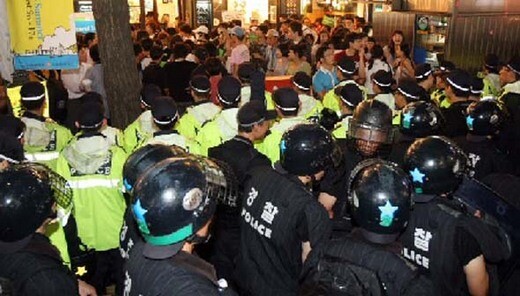hankyoreh
Links to other country sites 다른 나라 사이트 링크
Police indiscriminately arrest civilians observing candlelight demonstrations

The government’s response to the candlelight demonstrations is crossing a line. After using a water cannon mixed with coloring at the 100th candlelight demonstration August 15, police arrested about 150 people simply because they were covered in the coloring. In the process, they indiscriminately arrested not only demonstration participants, but also citizens who were in the area. The legal world and human rights groups have criticized the arrest of people simply because they had coloring on them in a public area as a misuse of public power.
This was the second time police used the water cannon with coloring added; the first time was August 5 when U.S. President George W. Bush visited Korea. Yet even at that time, the police simply recorded demonstrators or arrested at the scene some demonstrators categorized as radical. The August 15 arrests, however, were based not on witnessed “actions,” but were carried out because police saw the individuals had coloring on them. This was basically an expedient way for police to suppress the protests, treating anyone who had coloring on them as criminals.
A company of plainclothes police who formed an arrest team was deployed that day, too. They stood on the sidewalks like anyone else, but jumped into action to arrest people with coloring on their clothing or bags once the water cannon started firing. In the process, they did not notify the suspects of their Miranda rights, nor did they respond to demands by the apprehended to identify themselves. Police shot the water cannon at citizens on the sidewalk and reporters covering the demonstration, and used violence against human rights violation monitors who protested the illegal arrests.
Thanks to these reckless arrests, not only the demonstration participants, but also a good many citizens who were in the area were apprehended. The People’s Countermeasure Council against Mad Cow Disease claimed that citizens eating snack food at area stalls who got coloring on them and people who were hit by the water cannon as they came out of coffee shops were arrested.
Even plainclothes police who got the coloring on them were almost arrested by other police officers. This happened because the cannon’s coloring-mixed water sprayed out in hard-to-predict directions, and police made as their basis for arrest the existence of the coloring on the suspect only.
Some 39 human rights groups, including the Conference of Human Rights Groups and Lawyers for a Democratic Society, released a statement August 17 calling the police’s behavior so wanton and illegal that it would be impossible to call it official duty. They said police had used a helicopter to spray colored water on demonstrators and used that as a basis of arrest in 1996 during protests at Yonsei University, but at that time, the demonstrators were physically isolated, making it completely different from the situation on August 15.
Lawyer Song Sang-gyo said the presence of the coloring on a suspect only indicates they were in a certain place at a certain time; it does not show what they did or even if they participated in the demonstration. He said apprehending people based on this was a misuse of the police’s power to arrest suspects for flagrant offenses. A judge with the Seoul Central District Court said that if police are going to arrest people with coloring on them for flagrant offenses, they need to prove that they fired the water cannon at demonstration participants only, and that nobody besides them was hit.
Please direct questions or comments to [englishhani@hani.co.kr]
Editorial・opinion
![[Column] Has Korea, too, crossed the Rubicon on China? [Column] Has Korea, too, crossed the Rubicon on China?](https://flexible.img.hani.co.kr/flexible/normal/500/300/imgdb/original/2024/0419/9317135153409185.jpg) [Column] Has Korea, too, crossed the Rubicon on China?
[Column] Has Korea, too, crossed the Rubicon on China?![[Correspondent’s column] In Japan’s alliance with US, echoes of its past alliances with UK [Correspondent’s column] In Japan’s alliance with US, echoes of its past alliances with UK](https://flexible.img.hani.co.kr/flexible/normal/500/300/imgdb/original/2024/0419/2317135166563519.jpg) [Correspondent’s column] In Japan’s alliance with US, echoes of its past alliances with UK
[Correspondent’s column] In Japan’s alliance with US, echoes of its past alliances with UK- [Editorial] Does Yoon think the Korean public is wrong?
- [Editorial] As it bolsters its alliance with US, Japan must be accountable for past
- [Guest essay] Amending the Constitution is Yoon’s key to leaving office in public’s good graces
- [Editorial] 10 years on, lessons of Sewol tragedy must never be forgotten
- [Column] A death blow to Korea’s prosecutor politics
- [Correspondent’s column] The US and the end of Japanese pacifism
- [Guest essay] How Korea turned its trainee doctors into monsters
- [Guest essay] As someone who helped forge Seoul-Moscow ties, their status today troubles me
Most viewed articles
- 1[Column] The clock is ticking for Korea’s first lady
- 2Hong Se-hwa, voice for tolerance whose memoir of exile touched a chord, dies at 76
- 3After 2 months of delayed, denied medical care, Koreans worry worst may be yet to come
- 4[Column] Has Korea, too, crossed the Rubicon on China?
- 5Samsung barricades office as unionized workers strike for better conditions
- 6US overtakes China as Korea’s top export market, prompting trade sanction jitters
- 7All eyes on Xiaomi after it pulls off EV that Apple couldn’t
- 8[Guest essay] How Korea turned its trainee doctors into monsters
- 9[Editorial] As it bolsters its alliance with US, Japan must be accountable for past
- 10[Correspondent’s column] In Japan’s alliance with US, echoes of its past alliances with UK